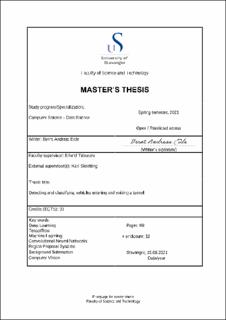| dc.description.abstract | Tunnel safety is an increasing concern for the road administrative authorities. In this thesis, a vision based surveillance system is developed as a safety measure. The main purpose of this surveillance system is to detect and classify incoming and outgoing vehicles, thus rescue workers will have an idea about which vehicles reside inside the tunnel at any given time.
The thesis builds its foundation on two previous theses from previous students at the University of Stavanger. In the previous work, the main bottleneck has been detection and classification during challenging lighting/illumination and/or weather conditions. To counter these challenges, transfer learning has been used to create a more solid model, and with explicit data that has been created for challenging lighting conditions. New techniques for detection has also been tested, such as region proposal networks.
For the region proposal system, the Single Shot Detector (SSD) MobileNet v2 pre-trained model has been used. This model has been trained on the popular Common Objects in Context (COCO) dataset, which consist of at least 200,000 annotated images, and span across 90 different classes.
As for the vanilla Convolutional Neural Network (CNN), MobileNet v3 has been used. This model has been trained on the ImageNet dataset, which consist of 14,197,122 annotated images.
Both models use transfer learning, thus, less data is required to train and build a solid model. 5560 images have been collected and annotated for the training of these models, the images contain roughly 21,325 objects spanning across five classes (car, truck, person, bike, bus).
Classification rates converge fast with almost every configuration, however, there are some challenges separating some of the minority classes. Practical considerations have also been taken into account, a system like this would most suitably be deployed on a low-cost micro-controller, such as an Internetof Things (IoT) device. | |
